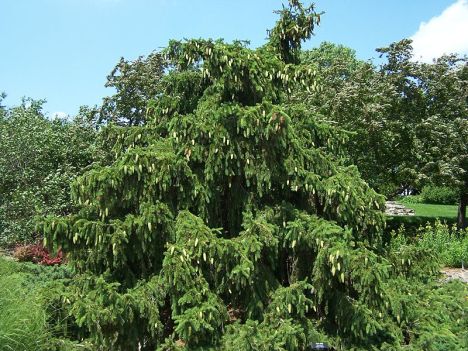Scientists have found a cluster of spruces in the mountains in western Sweden which, at an age of 8,000 years, may be the world's oldest living trees.The hardy Norway spruces were found perched high on a mountain side where they have remained safe from recent dangers such as logging, but exposed to the harsh weather conditions of the mountain range that separates Norway and Sweden.
Carbon dating of the trees carried out at a laboratory in Miami, Florida, showed the oldest of them first set root about 8,000 years ago, making it the world's oldest known living tree, Umea University Professor Leif Kullman said.
California's "Methuselah" tree, a Great Basin bristlecone pine, is often cited as the world's oldest living tree with a recorded age of between 4,500 and 5,000 years.
Two other spruces, also found in the course of climate change studies in the Swedish county of Dalarna, were shown to be 4,800 and 5,500 years old.
"These were the first woods that grew after the Ice Age," said Lars Hedlund, responsible for environmental surveys in the county of Dalarna and collaborator in climate studies there.
"That means that when you speak of climate change today, you can in these (trees) see pretty much every single climate change that has occurred."
Although a single tree trunk can become at most about 600 years old, the spruces had survived by pushing out another trunk as soon as the old one died, Professor Kullman said.
Rising temperatures in the area in recent years had allowed the spruces to grow rapidly, making them easier to find in the rugged terrain, he added.
"For quite some time they have endured as bushes maybe 1/2 meter tall," he said.
"But over the past few decades we have seen a much warmer climate, which has meant that they have popped up like mushrooms in the soil." - msnbc
Freepers want to cut it down, so the actual location and image of the trees is not being published. Why would anyone want to cut down a tree that has lived 8,000 years? Research ( Jack Glaser, UC Berkeley) says that republicans have more fear of and resistance to change. If true, death is the ultimate change. So, perhaps their fear of death translates to jealousy and rage at things which will out live them. "I have to die, so it should too!"
Agree? Disagree? Let me know.

4 comments:
Damn Xeno, I couldn't agree more with your existential analysis. Waste, existential angst, and the fear of death go hand in hand since The Song of Solomon in the Bible. Said poem encourages consumption and lack of care for tomorrow.
Free Republic =/= Republicans in the same way Democratic Underground =/= Democrats.
I imagine some people (who would tend to fall on the Republican side of the divide, like other types of nuts tend to fall on the Democratic side) would find this tree threatening because it is older than planet Earth, according to their worldview.
I'm finally home from work and intend on eating, drinking, and being merry, because tomorrow I go back to work. If that makes me an existentialist consumer, so be it! ;-)
In the beginning, there were trees .... Norway spruces to be exact. Just hanging in the void.
And after a few thousand years God decided they needed something...
So he made the Heavens as a sort of backdrop. Much better than the void.
And being quite pleased with himself about the Heavens, he went on to make Norway upon which the trees could sit.
But still, it was not enough. And so, he made the Earth, upon which Norway could sit.
And he saw it.
And it was good.
Beautiful, Xeno . . . a Christian form of a old tradition.
The Worship of Trees.
. . . . Amongst the Celts the oak-worship of the Druids is familiar to every one . . .. Sacred groves were common among the ancient Germans, and tree-worship is hardly extinct amongst their descendants at the present day. . . . At Upsala, the old religious capital of Sweden, there was a sacred grove in which every tree was regarded as divine. The . . . Slavs worshiped trees and groves. The Lithuanians were not converted to Christianity till towards the close of the fourteenth century, and amongst them at the date of their conversion the worship of trees was prominent. Some of them revered remarkable oaks and other great shady trees, from which they received oracular responses. Some maintained holy groves about their villages or houses, where even to break a twig would have been a sin. They thought that he who cut a bough in such a grove either died suddenly or was crippled in one of his limbs. Proofs of the prevalence of tree-worship in ancient Greece and Italy are abundant. In the sanctuary of Aesculapius at Cos, for example, it was forbidden to cut down the cypress-trees under a penalty of a thousand drachms. But nowhere, perhaps, in the ancient world was this . . . form of religion better preserved than in the heart of the great metropolis itself. In the Forum, the busy centre of Roman life, the sacred fig-tree of Romulus was worshipped down to the days of the empire, and the withering of its trunk was enough to spread consternation through the city. Again, on the slope of the Palatine Hill grew a cornel-tree which was esteemed one of the most sacred objects in Rome. Whenever the tree appeared to a passer-by to be drooping, he set up a hue and cry which was echoed by the people in the street, and soon a crowd might be seen running helter-skelter from all sides with buckets of water, as if (says Plutarch) they were hastening to put out a fire. . . . . Golden Bough Frazer, 1922
Post a Comment